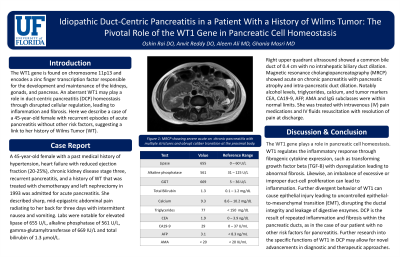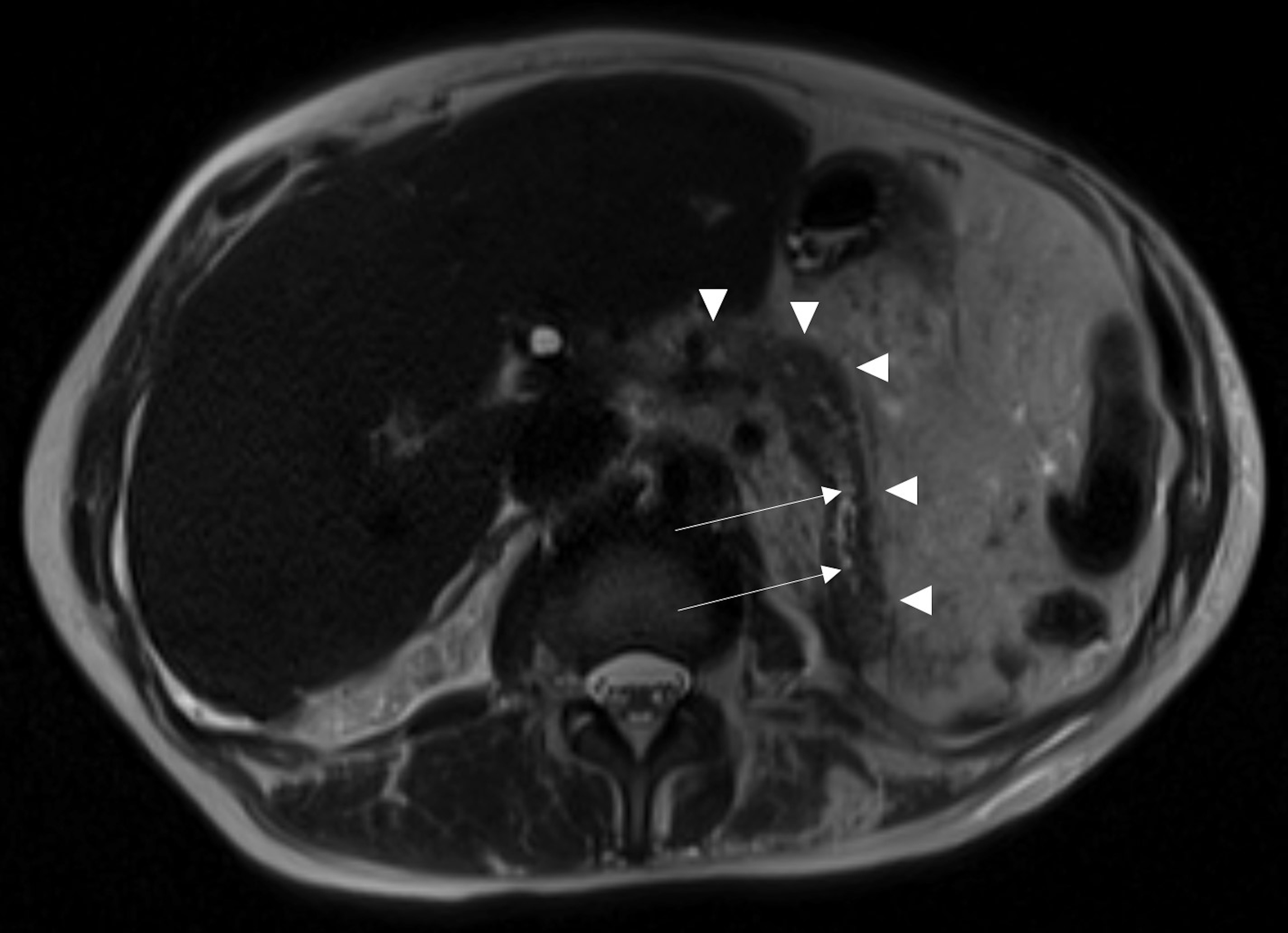Tuesday Poster Session
Category: Biliary/Pancreas
P3597 - Idiopathic Duct-Centric Pancreatitis in a Patient With a History of Wilms Tumor: The Pivotal Role of the WT1 Gene in Pancreatic Cell Homeostasis
Tuesday, October 29, 2024
10:30 AM - 4:00 PM ET
Location: Exhibit Hall E

Has Audio

Oshin Rai, DO
University of Florida College of Medicine
Jacksonville, FL
Presenting Author(s)
Oshin Rai, DO1, Anvit D. Reddy, DO1, Rebekah Padilla, MD2, Aleem A. Ali, MBBS2, Masri Ghania, MD2
1University of Florida College of Medicine, Jacksonville, FL; 2University of Florida Health Shands Hospital, Jacksonville, FL
Introduction: The WT1 gene is found on chromosome 11p13 and encodes a zinc finger transcription factor responsible for the development and maintenance of the kidneys, gonads, and pancreas. An aberrant WT1 may play a role in duct-centric pancreatitis (DCP) homeostasis through disrupted cellular regulation, leading to inflammation and fibrosis. Here we describe a case of a 45-year-old female with recurrent episodes of acute pancreatitis without other risk factors, suggesting a link to her history of Wilms Tumor (WT).
Case Description/Methods: A 45-year-old female with a past medical history of hypertension, heart failure with reduced ejection fraction, chronic kidney disease stage three, recurrent pancreatitis, and a history of WT that was treated with chemotherapy in 1993 was admitted for acute pancreatitis. She described sharp, mid-epigastric abdominal pain radiating to her back for three days with intermittent nausea and vomiting. Labs were notable for elevated lipase of 655 U/L, alkaline phosphatase of 561 U/L, gamma-glutamyltransferase of 669 IU/L and total bilirubin of 1.3 μmol/L. Right upper quadrant ultrasound showed a common bile duct of 0.4 cm with no intrahepatic biliary duct dilation. Magnetic resonance cholangiopancreatography (MRCP) showed acute on chronic pancreatitis with pancreatic atrophy and intra-pancreatic duct dilation. Notably alcohol levels, triglycerides, calcium, and tumor markers CEA, CA19-9, AFP, AMA and IgG subclasses were within normal limits. She was treated with intravenous (IV) pain medications and IV fluids resuscitation with resolution of pain at discharge.
Discussion: The WT1 gene plays a role in pancreatic cell homeostasis. WT1 regulates the inflammatory response through fibrogenic cytokine expression, such as transforming growth factor beta (TGF-B) with dysregulation leading to abnormal fibrosis. Likewise, an imbalance of excessive or improper duct-cell proliferation can lead to inflammation. Further divergent behavior of WT1 can cause epithelial injury leading to uncontrolled epithelial-to-mesenchymal transition (EMT), disrupting the ductal integrity and leakage of digestive enzymes. DCP is the result of repeated inflammation and fibrosis within the pancreatic ducts, as in the case of our patient with no other risk factors for pancreatitis. Further research into the specific functions of WT1 in DCP may allow for novel advancements in diagnostic and therapeutic approaches.

Disclosures:
Oshin Rai, DO1, Anvit D. Reddy, DO1, Rebekah Padilla, MD2, Aleem A. Ali, MBBS2, Masri Ghania, MD2. P3597 - Idiopathic Duct-Centric Pancreatitis in a Patient With a History of Wilms Tumor: The Pivotal Role of the WT1 Gene in Pancreatic Cell Homeostasis, ACG 2024 Annual Scientific Meeting Abstracts. Philadelphia, PA: American College of Gastroenterology.
1University of Florida College of Medicine, Jacksonville, FL; 2University of Florida Health Shands Hospital, Jacksonville, FL
Introduction: The WT1 gene is found on chromosome 11p13 and encodes a zinc finger transcription factor responsible for the development and maintenance of the kidneys, gonads, and pancreas. An aberrant WT1 may play a role in duct-centric pancreatitis (DCP) homeostasis through disrupted cellular regulation, leading to inflammation and fibrosis. Here we describe a case of a 45-year-old female with recurrent episodes of acute pancreatitis without other risk factors, suggesting a link to her history of Wilms Tumor (WT).
Case Description/Methods: A 45-year-old female with a past medical history of hypertension, heart failure with reduced ejection fraction, chronic kidney disease stage three, recurrent pancreatitis, and a history of WT that was treated with chemotherapy in 1993 was admitted for acute pancreatitis. She described sharp, mid-epigastric abdominal pain radiating to her back for three days with intermittent nausea and vomiting. Labs were notable for elevated lipase of 655 U/L, alkaline phosphatase of 561 U/L, gamma-glutamyltransferase of 669 IU/L and total bilirubin of 1.3 μmol/L. Right upper quadrant ultrasound showed a common bile duct of 0.4 cm with no intrahepatic biliary duct dilation. Magnetic resonance cholangiopancreatography (MRCP) showed acute on chronic pancreatitis with pancreatic atrophy and intra-pancreatic duct dilation. Notably alcohol levels, triglycerides, calcium, and tumor markers CEA, CA19-9, AFP, AMA and IgG subclasses were within normal limits. She was treated with intravenous (IV) pain medications and IV fluids resuscitation with resolution of pain at discharge.
Discussion: The WT1 gene plays a role in pancreatic cell homeostasis. WT1 regulates the inflammatory response through fibrogenic cytokine expression, such as transforming growth factor beta (TGF-B) with dysregulation leading to abnormal fibrosis. Likewise, an imbalance of excessive or improper duct-cell proliferation can lead to inflammation. Further divergent behavior of WT1 can cause epithelial injury leading to uncontrolled epithelial-to-mesenchymal transition (EMT), disrupting the ductal integrity and leakage of digestive enzymes. DCP is the result of repeated inflammation and fibrosis within the pancreatic ducts, as in the case of our patient with no other risk factors for pancreatitis. Further research into the specific functions of WT1 in DCP may allow for novel advancements in diagnostic and therapeutic approaches.

Figure: Figure 1: Axial T2-weighted HASTE sequence images demonstrate diffuse pancreatic atrophy (white arrow heads) and a chronic cystic dilatation of the main pancreatic duct (white arrows).
Disclosures:
Oshin Rai indicated no relevant financial relationships.
Anvit Reddy indicated no relevant financial relationships.
Rebekah Padilla indicated no relevant financial relationships.
Aleem Ali indicated no relevant financial relationships.
Masri Ghania indicated no relevant financial relationships.
Oshin Rai, DO1, Anvit D. Reddy, DO1, Rebekah Padilla, MD2, Aleem A. Ali, MBBS2, Masri Ghania, MD2. P3597 - Idiopathic Duct-Centric Pancreatitis in a Patient With a History of Wilms Tumor: The Pivotal Role of the WT1 Gene in Pancreatic Cell Homeostasis, ACG 2024 Annual Scientific Meeting Abstracts. Philadelphia, PA: American College of Gastroenterology.
